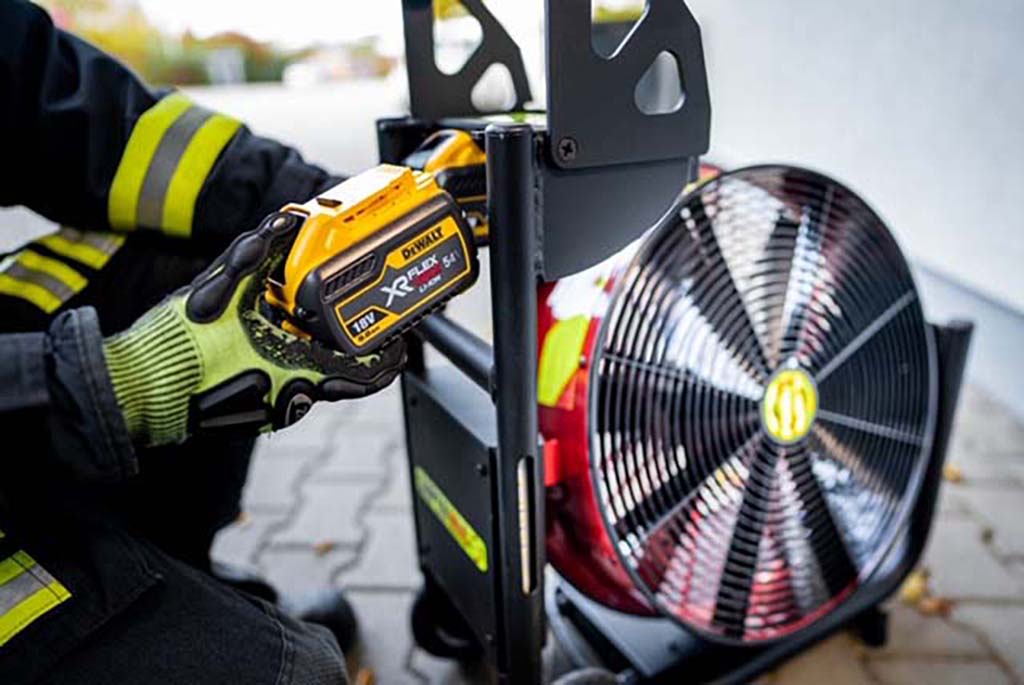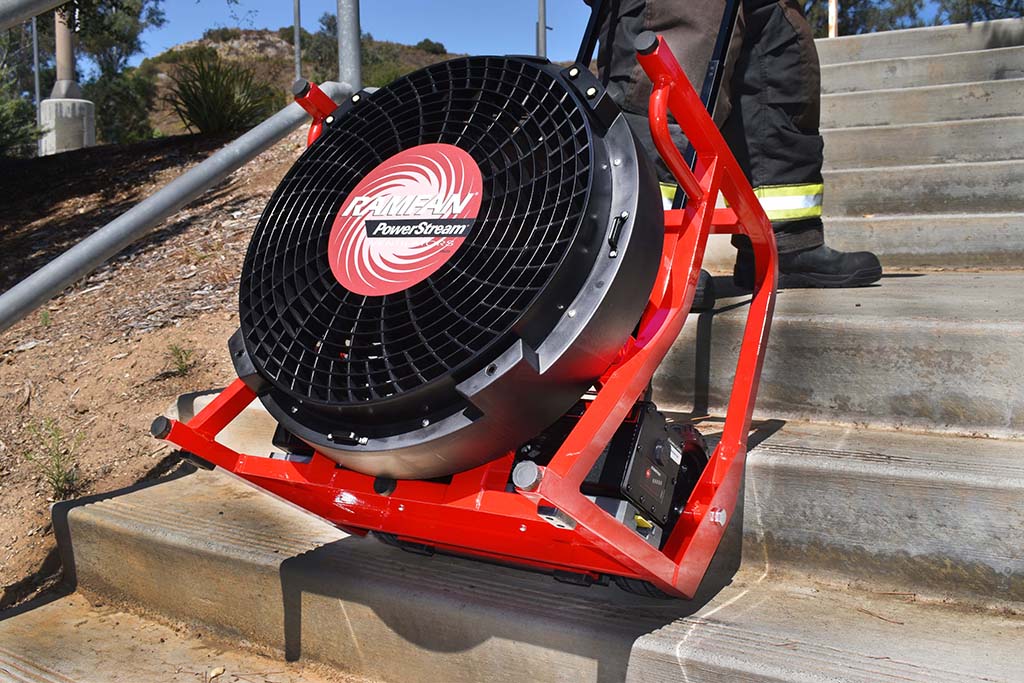Thirty-one years ago, my fire company was running two engines and a rescue truck. The two pumpers had generators, one cord reel each, and a smoke ejector on each.
This was before positive pressure ventilation (PPV) really took off. After a room-and-contents fire, one of us would bring one of the smoke ejectors inside, put it in the window of the affected room (facing the right way, of course), and turn it on for a while to clear out the smoke. If there was a bit more smoke to clear, we’d set up a gas-powered PPV fan at the front door and use that method.
The rescue truck had two large electric smoke ejectors and the gas-powered PPV fan. The two large smoke ejectors could really move some air, and when you stacked them, you would basically have a wind tunnel. Subsequent engines had generators and cord reels, and while the rescue would still carry at least one smoke ejector, most of our fans had been switched over to electric PPV fans. With our most recent engine purchases, we don’t have generators or cord reels, and now we’ve got battery-powered PPV fans. We’ve come a long way in 30 years.
- Ventilation Equipment Gets More Compact, Powerful
- Ventilation Equipment Ranges from Compact to Very Large
- Ventilation Equipment Blasts to New Levels
Along with the units themselves evolving over time, so has the standard that outlines the performance requirements and test methods for firefighting PPV fans: AMCA 240.
AMCA 240-22
Zach Allen, vice president, Euramco Group and voting member of the AMCA 240-22 Review Committee, explains that AMCA 240 is a standard by the Air Movement and Control Association (AMCA) International. It has been in place since the early 1990s. The purpose of AMCA 240-22, according to Mehdi Achour, international salesengineer at SuperVac, is to establish a uniform method of laboratory testing to demonstrate the performance of a PPV fan in terms of airflow rate, air density, pressure, rpm, and battery runtime (the length of time a battery PPV fan operates at maximum speed before automatically shutting off for the first time).

“The 2022 revision follows the five revisions before it with some basic updates to keep up with the evolving pace of technology, but the fundamental test procedures to determine volumetric airflow remain unchanged,” says Allen. “AMCA 240 has always had several requirements that manufacturers must note along with airflow—this is the test configuration including setback from the door and tilt angle of the fan, both of which significantly affect airflow volume through the structure.” Achour adds that AMCA 240-22 is a laboratory method for testing positive pressure ventilators for aerodynamic performance rating.
Allen explains that the -22 revision adds the requirement to note nominal voltage and battery model used on all test reports and also implements new procedures for battery-powered PPV fans to be tested on DC power, simulating battery use as intended by firefighters. “After standard AMCA 240 volume tests are completed on the test stand, a check test for runtime using the specified batteries is done using test fan configuration,” he says. He adds that prior to -22, how to power electric fans was ambiguous, assuming they would be plugged into AC power. He also notesthat batteries cannot be used during flow testing because the AMCA 240 flow test requires 15 to 25 minutes to gather accurate data through the zero- pressure test stand. “Portable batteries are limited in capacity,” he says. “And because battery voltage continuously drops as soon as fan operations begin, fan rpm can reduce over time, resulting in skewed flow measurements.” For that reason, AMCA standardized on using a constant-voltage DC power supply to simulate nominal voltage, which is the battery industry standard for rating lithium cells at their average voltage, midway between fully charged and fully discharged states.

Importance
Allen states that the fire service needs to be aware of AMCA 240-22 because it establishes that battery- powered PPV fans should be tested under DC power conditions. Achour adds that compliance with the standard will provide realistic, tested, and certified airflow and runtime numbers to fire departments, since this is the first time battery runtimes have been added to the standard. He also cautions that certified fans need to be retested every three years to ensure they still provide the same performance. “Failing to comply will result in termination of the certificate,” he says.
Why is this important to the fire service? According to Allen, it expands an already well-known, longstanding performance comparison tool in the firefighting industry into battery PPV fans—which is now the most popular category, at least in North America.
“All product categories should strive to maintain a reasonable level of standardization to give buyers a trustable tool with which to compareoptions,” he says.
The main changes in the -22 version of the standard are how to power battery fans during the test, according to Allen. He adds that complying with AMCA 240-22 does not fundamentally change AMCA 240 airflow testing.
The flow testing procedures remain unchanged. So, in that way, the impact to the fire service when complying with AMCA 240-22 is not significant. “PPV fans that have been consistently tested to AMCA 240 standards over the years are still the same trusted options for fire departments,” he says. “AMCA 240 is the world’s only third-party standardization test procedure that is accessible to all manufacturers of PPV fans.”
Achour explains that buying a fan or comparing its performance is always a difficult decision, and buyers do not always know the origin of the values that appear in brochures or the methods for testing. “Performance of a PPV is crucial for firefighters, pushing smoke and toxic gases out to clear visibility inside, making it easier to locate and rescue victims,” he says.
“The AMCA standard is often put forward as it is a third-party certifying laboratory that brings together all manufacturers who want to test their products in a transparent and uniform way.” Allen concurs. “At the end of the day, AMCA 240 is a shopping tool,” he says. “Without a standard test method, firefighters have no way to compare one fan to another without blind trust in the marketing sheets, which is a dangerous gamble.”
Allen also suggests that departments should always insist on third-party standardized testing when procuring PPV fans “as the only way to truly and fairly compare fan performance in intended use—the way firefightersdeploy fans in the real world, albeit in a controlled test environment to maintain comparability from fan to fan, year to year.”
One impact -22 does have on the fire service, according to Allen, is that it defines the methodology for powering battery fans during tests. Until now, this has been different from manufacturer to manufacturer, with most testing on AC power, which he says could produce different results than what firefighters would see in actual deployment.
The Horizon
Most, if not all, standards have a regular revision cycle, and for AMCA 240, that cycle is every five years, although Allen says it was delayed during COVID. In some ways, the technology behind the battery- powered fans and performance factors will likely influence the next edition. “We’re already reaching the limits of performance that can be squeezed from PPV fans using small, portable battery packs,” he says. “The standard is almost outdated already.” He explains that the average battery fan today is at about 50% less performance than its gas counterparts. To address the power limitations, he says, higher- voltage packs will be necessary to reduce current draw. “But,” he adds, “simple battery size/capacity needs to grow significantly to get PPV fans back to where they were before battery fans. That’s not a good evolution for firefighters, tactically speaking, despite being cleaner in emissions.” Allen suggests that PPV fans in the future will most likely remain electric, but he says it is already trending back toward plug-in electric models. These models, however, are much lighter because of recent developments in brushless technology as demand for greater performance continues to grow. “The standard for high-performance plug-in electric fans has existed for more than two decades,” he says.
When we buy a fire apparatus, we ensure it complies with the standard that establishes safety parameters for the rig. We do the same thing with our personal protective equipment. In these cases, we are complying with National Fire Protection Association (NFPA) standards. These standards help ensure that the products we are purchasing meet a baseline standard and help us choose what manufacturer to use. AMCA 240 is no different. “As in any product category, be it washing machines or fire apparatus turntable ladders, standardized testing procedures are critical in building customers’ confidence in their equipment procurement decisions,” says Allen. “AMCA 240 does that for PPV fans. That being said, AMCA only tests airflow under controlled conditions in a lab. This is not a comprehensive standard for build quality or safety like the NFPA. More critical needs for standard development are becoming apparent as we get deeper into this new tech-focused phase of the industry.”
Allen cites fan safety features, such as embedded accelerometers to automatically shut down if a fan falls over, common in power tools for a couple of years, are now being added to PPV fans. “This should be a basic requirement, at least in procurement specs, to protect firefighters from injury,” he says. “Standards tend to lag behind industry by at least five years. This standard is covering technology that was introduced in the 2010s. New discussions should be had to address the amazing pace of tech that is in the market now.”
CHRIS Mc LOONE, editor in chief of Fire Apparatus & Emergency Equipment, is a 31-year veteran of the fire service currently serving as a safety officer and is a former assistant chief with Weldon Fire Company (Glenside, PA). He has served on past apparatus and equipment purchasing committees. He has also held engineering officer positions, where he was responsible for apparatus maintenance and inspection. He has been a writer and an editor for more than 30 years.

